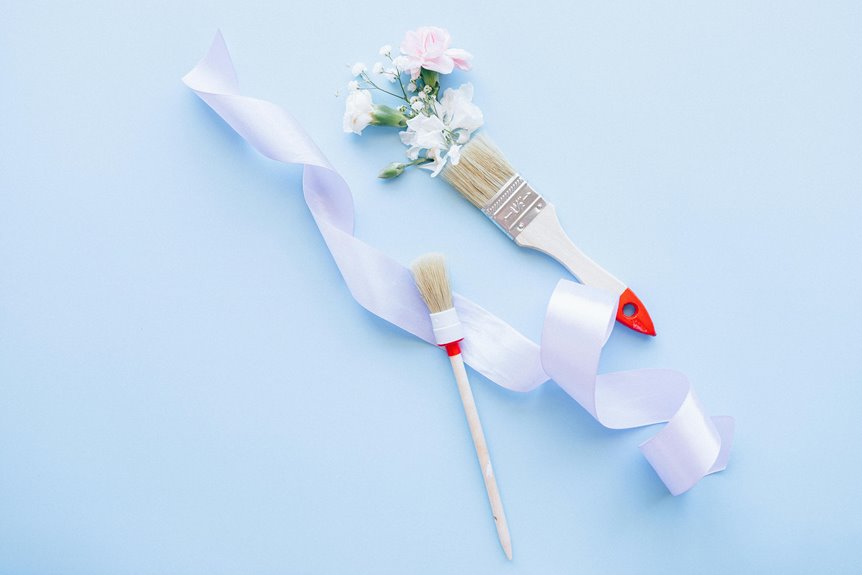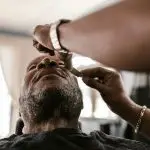To keep your DIY fabric panels looking great, first know your fabric type for specific care. Regularly dust or vacuum them to remove debris. For stains, gently blot and use a mild soap solution, testing it first. If they’re machine-washable, wash on a gentle cycle with cold water and a gentle detergent. Air dry completely before re-hanging. To avoid wear, regularly rotate and treat with a fabric protector. Discover more tips to maintain that fresh look!
Table of Contents
Key Takeaways
- Regularly vacuum fabric panels with a soft brush attachment to remove dust and prevent buildup.
- Spot clean stains promptly using a mild soap solution and avoid rubbing the fabric.
- Follow specific washing instructions on fabric care labels for machine-washable materials.
- Use a fabric protector spray to repel stains and maintain the fabric’s appearance.
- Avoid direct sunlight to prevent fading and rotate panels to distribute wear evenly.
Understanding Fabric Types and Their Care Requirements
When you’re choosing fabric for your DIY panels, it’s essential to understand the different types and their specific care requirements.
Cotton is versatile and easy to clean, often machine washable, making it a popular choice. On the other hand, linen offers a natural texture but wrinkles easily, so you’ll want to handle it with care.
Cotton is easy to maintain, while linen’s natural beauty comes with a tendency to wrinkle.
Polyester is durable and resistant to stains, but it can retain heat, which mightn’t be ideal for all settings. Velvet adds elegance but requires special cleaning methods, often needing professional care.
Ultimately, consider blends, which can combine the best features of different fabrics. Knowing these characteristics will help you select the right fabric that suits your lifestyle and cleaning preferences.
General Cleaning Tips for Fabric Panels
To keep your DIY fabric panels looking fresh and vibrant, regular cleaning is essential. Start by vacuuming your panels using a soft brush attachment to remove dust and debris. This simple step can prevent dirt from embedding into the fabric.
If your panels are removable, consider taking them outside and gently shaking them to dislodge any trapped particles. For a deeper clean, spot-test a fabric-safe cleaner on a small area first. Always follow the manufacturer’s care instructions, as different fabrics may require specific methods.
Avoid soaking your panels or using harsh chemicals that can damage the fibers. Finally, if they’re machine washable, wash on a delicate cycle and air dry to maintain their shape and texture.
Spot Cleaning Techniques for Stains
Regular cleaning keeps your DIY fabric panels looking their best, but accidents happen, and stains can occur. When you face a stain, don’t panic! Here are some effective spot cleaning techniques:
- Blot, don’t rub: Use a clean cloth to blot the stain gently; rubbing can worsen it.
- Use mild soap: Mix water with a few drops of mild dish soap for a gentle cleaning solution.
- Test first: Always test your cleaning solution on a hidden area to prevent discoloration.
- Rinse and blot: After treating the stain, rinse with clean water and blot to remove any soap residue.
- Air dry: Let the area air dry completely to avoid mildew and guarantee your fabric stays fresh.
These steps will help you tackle stains effectively!
Washing and Drying Guidelines for Machine-Washable Fabrics
When it comes to washing machine-friendly fabrics, you should always check the care labels for specific instructions.
Using the right washing techniques can help maintain the fabric’s quality, while appropriate drying methods will guarantee your panels last longer.
Let’s explore how to properly care for your DIY fabric panels.
Fabric Care Labels
Although fabric care labels might seem small and insignificant, they play an essential role in ensuring your machine-washable fabrics stay in top condition.
By following their guidelines, you can prevent damage and maintain the fabric’s appearance.
Here’s what to look for:
- Washing Temperature: Check if it’s safe to wash in cold, warm, or hot water.
- Cycle Type: Look for recommendations on gentle or regular cycles.
- Bleach Instructions: Determine if you can use bleach or need to avoid it.
- Drying Method: See if air drying is preferred or if it’s safe to tumble dry.
- Ironing Guidelines: Know the appropriate heat settings for ironing.
Washing Techniques
Understanding fabric care labels sets the foundation for effective washing techniques.
First, sort your fabric panels by color and fabric type to prevent bleeding and damage. Use a gentle cycle and cold water for most materials to preserve colors and textures.
When it comes to detergent, choose a mild, eco-friendly option that’s suitable for delicate fabrics. Avoid using bleach, as it can weaken fibers and alter colors.
If your fabric panels have embellishments or are particularly delicate, consider placing them in a mesh laundry bag for extra protection.
Always check for any stains before washing, treating them with a suitable stain remover.
Following these guidelines will help keep your DIY fabric panels looking fresh and vibrant for years to come.
Drying Methods
To preserve the quality of your DIY fabric panels, you’ll want to choose the right drying method after washing.
Here are some effective drying techniques you can use:
- Air Drying: Hang panels in a well-ventilated area to prevent shrinkage.
- Tumble Drying: Use a low heat setting to maintain fabric integrity.
- Flat Drying: Lay panels flat on a clean surface to prevent distortion.
- Avoid Direct Sunlight: Keep fabrics out of harsh sunlight to prevent fading.
- Check for Dampness: Verify panels are completely dry before re-hanging to avoid mildew.
Maintaining Color and Texture
While your DIY fabric panels can add vibrant color and texture to your space, maintaining their appearance requires regular attention. To keep those colors looking fresh, avoid exposing your panels to direct sunlight for long periods, as UV rays can cause fading. Instead, rotate your panels occasionally to guarantee even exposure.
When it comes to cleaning, always follow the fabric’s care instructions. Use a gentle detergent and avoid bleach, which can strip color.
For textured fabrics, gently brush them with a soft brush to remove dust without damaging the fibers. If you notice any stains, treat them promptly to prevent discoloration.
Preventive Measures to Keep Fabric Panels Looking New
Three simple preventive measures can keep your DIY fabric panels looking new for years.
By taking a few proactive steps, you can minimize wear and tear, ensuring they remain vibrant and fresh.
- Regular Dusting: Use a soft cloth or vacuum with a brush attachment to remove dust and dirt.
- Avoid Direct Sunlight: Position your panels away from direct sunlight to prevent fading.
- Use Fabric Protectors: Apply a fabric protector spray to repel stains and spills.
- Rotate Panels: If possible, rotate them occasionally to distribute wear evenly.
- Handle with Care: Be gentle when cleaning or adjusting your panels to avoid stretching or tearing.
Implementing these measures will help your fabric panels stay beautiful and extend their lifespan.
Frequently Asked Questions
Can I Use Fabric Softener on My DIY Fabric Panels?
You shouldn’t use fabric softener on your DIY fabric panels. It can leave a residue that diminishes their breathability and may affect the fabric’s ability to repel dust and allergens. Stick to mild detergents for cleaning instead.
How Often Should I Vacuum Fabric Panels?
You’d think fabric panels are immune to dust, huh? Well, you should vacuum them at least once a month. It keeps them looking fresh and prevents allergens from settling in, making your space feel cleaner overall.
What Tools Are Best for Cleaning Fabric Panels?
To clean fabric panels effectively, you’ll need a vacuum with an upholstery attachment, a soft brush for gentle scrubbing, and a lint roller for quick touch-ups. These tools help keep your panels looking fresh and clean.
Can I Use Bleach on My Fabric Panels?
Did you know that 80% of fabric damage comes from improper cleaning? You shouldn’t use bleach on your fabric panels, as it can weaken fibers and cause discoloration. Stick to milder cleaners for best results.
Are There Specific Storage Tips for Fabric Panels?
When storing fabric panels, keep them in a cool, dry place. Avoid direct sunlight to prevent fading, and use breathable bags to protect against dust. Folding them gently guarantees they stay wrinkle-free and ready for use.




